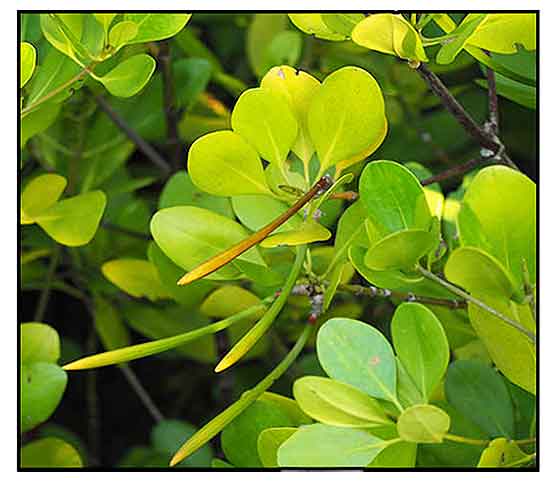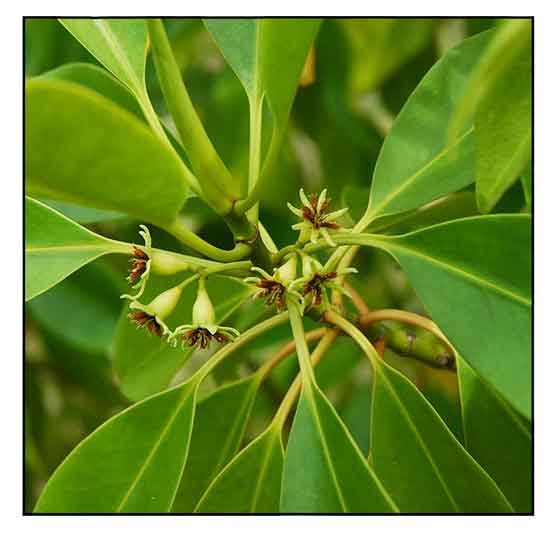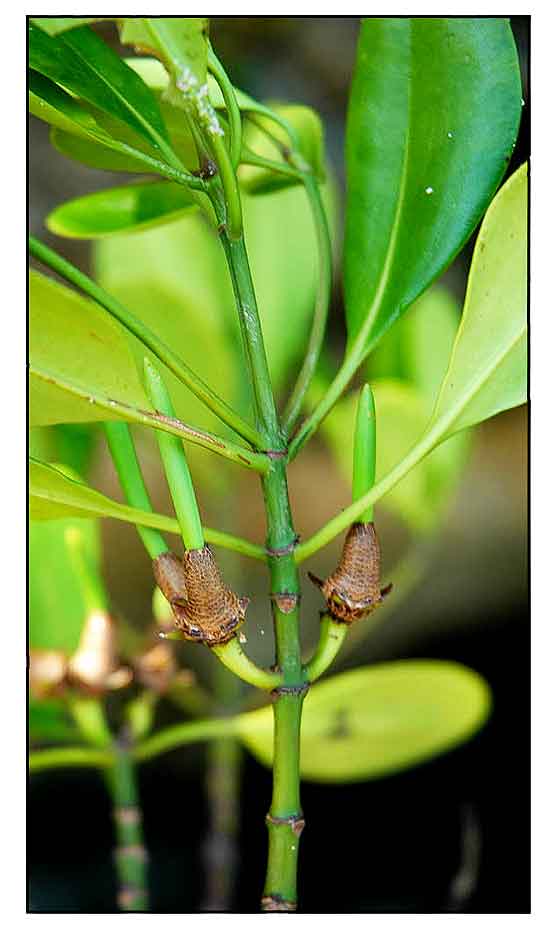Gen info
- Ceriops decandra is a mangrove plant of tropical Asia in the family Rhizophoraceae.
- Etymology: The specific epithet
is derived from Greek decandra, "ten male", referring to the flower having ten stamens. (3)
 Botany Botany
• A straight columnar tree, usually of small to medium size, but under favorable conditions attaining a height of 35 m and a diameter of the trunk of 35 cm, with a relatively narrow crown and short basal buttresses which appear to develop from the fusion of clusters of stilt roots; roots superficial, spreading radially, with small knobby and/or looping pneumatophores in wet sites; bark whitish or pale gray, smooth but slightly fissured towards the base, peeling around the buttresses; branches conspicuously jointed with swollen nodes. Leaves opposite, clustered at the end of the twigs, coriaceous, obovate to elliptic-oblong, 4.5-10 cm x 2.5-6 cm, cuneate at base, rounded or subemarginate at apex, glabrous and glossy; petiole 1-2.5 cm long, with lanceolate, 1.5-2.5 cm long deciduous stipules at base. Flowers in head-like, condensed up to 5-flowered cymes in leaf-axils at the upper part of a branch, 5-6-merous, 5-6 mm long, with deeply lobed calyx and white ca. 2.5 mm long petals, fringe-like divided at the apex; stamens twice the number of calyx lobes, anthers longer than filaments; ovary semi-inferior, 3-celled. Fruit an ovoid-conical berry, 1-1.8 cm long, with persistent erect or ascending calyx lobes, blunt basally, warty at the apex. Seeds viviparous. Hypocotyl club-shaped, protruding below the fruit while this is still attached to the tree, 9-15 cm long, occasionally longer (e.g. in New Guinea), slightly fluted. (2)
Distribution
- Native to the Philippines.
-
Also native to Andaman Is., Bangladesh, Borneo, Cambodia, India, Jawa, Lesser Sunda Is., Malaya, Maluku, Myanmar, New Guinea, Northern Territory, Queensland, Sri Lanka, Sulawesi, Sumatera, Thailand, Vietnam. (1)
- Most commonn in tidal forest in high rainfall regions, where it grows in the middle to landward parts of the mangrove swamp. Grows best immediately behind forest strip lining rivers, and on slightly higher muddy tidal flats behind, between rivers and creeks. (2)
 Constituents Constituents
- Phytochemical screening of leaf extract revealed presence of sugars, protein, phenolic groups, alkaloids, triterpenoids, flavonoids, catechin, tannins, and anthraquinones. (see study below) (4)
- Study of C. decandra bark isolated eleven new diterpenes, named decandrins A-K (1-11), including nine abietanes (1-9) and two podocarpanes (10-11). (5)
-
Study of roots isolated nine new ent-abietanes, names decandrols A-I (1-9), together with six previously reported abietanes (10-15). (see study below) (6)
- Phytochemical analysis revealed presence of high phenolics (GAE 42.33-163.44 mg/g), flavonoids (QE 39.16-582.22 mg/g), tannins (TAE 16.71-134.77 mg/g), alkaloids (34.04-150.50 mg/g), and saponins (16-38 mg/g). (see study below)
(9)
- Total phenolic and flavonoid contents of bark were 258.33 mg gallic acid equivalents (GAE)/g dry material and 15 mg
if quercetin equivalents (QE)/g dry material. (see study below) (12)
- Study of dichloromethane extract of leaves isolated
3β-E-coumaroylbetulinic acid (1), lupeol fatty acid esters (2), betulonic acid (3), betulin (4), betulinic acid (5), lupeol (6), lupenone (7), and a mixture of 3β-E-feruloyllupeol (8) and 3β-Z-feruloyllupeol (9), and chlorophyll a (10). (19)
- Phytochemical screening of leaves yielded steroids, tannins, and saponins; bark, steroids and saponins; and pneumatophore, steroids and tannins.
(see study below) (22)
 Properties Properties
- Studies have suggest hepatoprotective, antioxidant, NF-kB inhibitory, anti-inflammatory, anticancer, antioxidant, antihemolytic, antidiabetic, antinociceptive, antidiarrheal, α-amylase inhibitory, cytotoxicity, anti-ulcer properties.
Parts used
Leaves, roots, bark.
Uses
Folkloric
- No reported folkloric medicinal use in the Philippines.
-
Traditionally used for treatment of wounds, boils, hepatitis, ulcers, angina, diabetes, diarrhea, dysentery, snake bites, cancer.
- Whole plant is astringent. Bar used to stop hemorrhage and applied to malignant ulcers. Leaves used for treatment of pain.
- In the Sundarban forest region of India, leaf decoction used to stop hemorrhage.
Others
- Tannin: Tannin from the bark used for treating and preservation of cotton fishing nets. (20) (21)
Studies
• Hepatoprotective / Carbon Tetrachloride Toxicity / Leaves: Studies evaluated the hepatoprotective and antioxidant activities of plant parts (leaf, bark, collar, flower, and hypocotyls) of C. decandra in CCl4 induced toxicity in Wistar albino rats. Oral toxicity study showed non-toxicity of extract up to 2000 mg/kbw. In vitro antioxidant studies used DPPH, HRSA, NO, FRAP and LPO assays. Leaf extract showed maximum antioxidant scavenging properties. Leaf extract treated animals showed decreased level of enzymatic properties, which may be due to stabilization of hepatic cellular membrane, inhibition of lipid peroxidation and radical scavenging properties. (4)
• Ent-abietanes / NF-kB Inhibitory Activity / Anti-Inflammatory / Roots: Study of roots isolated nine new ent-abietanes, names decandrols A-I (1-9), together with six previously reported abietanes (10-15). Decandrol C (3) and E (5) exhibited significant NF-kB inhibitory activity at concentration of 100 µM. (NF-kB comprises a family of inducible transciption factors that serves as regulators of host immune and inflammatory response.) (6)
• Diuretic Effect / Terpenoids / Aerial Roots: Study evaluated the diuretic potential of aerial roots of Ceriops decandra (CD) and Ceriops tagal (CT) and the effectiveness of the plants' terpenoids enriched bioactive constituents against human carbonic anhydrase (hCA) enzyme through molecular docking. Both extracts exhibited substantial increase in urine volume, with CD being at top. Na+, K+, and Cl- concentrations increased with high dose of treatment (500 mg/kg). Both extracts at 500 mg/kg showed potent saluretic, natriuretic and CAE activity. Total terpenoid content of CD was significantly higher than CT. In molecular docking analysis, terpenoids from CD showed greater binding affinity against hCA isoforms. Acute toxicity assessment showed not sign of toxicity. (8)
• Antimicrobial / Leaf, Root, Wood, Bark: Study evaluated the antimicrobial activities of different solvent extracts of leaf, root, wood, and bark of C. decandra. Screening by disc diffusion method used two Gram positive (Bacillus subtilis and B. coagulans), two Gram negative ( Escherichia coli and Proteus vulgaris) and two fungi ( Saccharomyces cerevisiae and Aspergillus niger). Extracts exhibited significant antimicrobial activities against all microorganisms tested except A. niger. (see constituents above) (9)
• Comparative Pharmacological Activities / Ceriops decandra and C. tagal / Leaves: Study evaluated the comparative pharmacological activities of leaves of C. decandra (CD) and C. tagal (CT) using doses of 200 and 500 mg/kg. CD showed greater radical scavenging activity by DPPH assay, more significant lowering of blood glucose. CD produced a sedative effect at both doses. Both plants delayed prothrombin time in a dose dependent manner. CD significantly (p<0.05) reduced writhing inhibition at 54.55% and 66.37%. Both produced dose-dependent paralysis and death time of Paramphistomum cervi. LC50 values from brine shrimp lethality bioassay were 94.69 and 114.29 µg/ml for CD and CT, respectively. Ceriops decandra revealed more prominent pharmacological activities than C. tagal. (10)
• Anticancer Endophytic Fungi / Inhibition of Breast Cancer Growth: Study evaluated the anticancer potential of fungal extracts obtained from C. decandra and in-silico based identification of anticancer constituents from the fungal extracts. Fusarium oxysporum, Chlonostachys sp., Fusarium solani were identified from C. decandra. GC-MS analysis identified 80 compounds from the endophytic compounds. Molecular docking study confirmed the anticancer potential on breast cancer cells through estrogen receptor, with good binding affinities and interaction patterns. In molecular dynamic simulation studies, Isoparvifuran (CID_617473) and 2,4-di-tert-butylphenol (CID_7311) revealed a stable complex with the target protein of estrogen receptor alpha. Study suggests the endophytic fungi can be a potential source of bioactive (Isoparvifuranand 2,4-di-tert-butylphenol) pharmaceuticals to treat breast cancer through modulation of estrogen receptor alpha. (11)
• Antioxidant / Antihemolytic / Stem Bark: Study of methanol extract of stem bark exhibited high antiradical activity against DPPH, ABTS, and OH radicals. Reductive capacity of extracts increased with increasing concentration. The extract inhibited H2O2 induced hemolysis in cow blood erythrocytes. Antioxidant activity was stronger than reference standard, butylated hydroxy toluene (BHT). (see constituents above) (12)
• Antidiabetic / Leaves: Study evaluated an ethanolic extract of leaves of C. decandra for antidiabetic activity in alloxan-induced diabetic rats. Glibenclamide was used as reference drug. Oral administration of the extract at 120 mg/kg modulated all the parameters evaluated (blood glucose, Hb, HbA1c, liver glycogen, carbohydrate metabolic enzymes). Results showed promising antidiabetic activity. (13)
• Antimicrobial Against Drug Resistant Pathogens / Leaves: Study evaluated aqueous and solvent extracts of leaves from nine plants against Methicillin resistant Staphylococcus aureus (MRSA), Vancomycin resistant S. aureus (VRSA) and Extended spectrum beta-lactamase (ESBL) strains. Out of nine mangrove plants, Ceriops decandra was one of four that showed antimicrobial activity against test pathogens. Methanol extract of C. decandra showed 12 mm inhibition against S. aureus and P. aeruginosa, and Rf value of 0.6. Active compound of C. decandra purified by TLC showed maximum activity of 16 mm against MRSA. (14)
• Anti-Inflammatory / Antioxidant / Bark: Study evaluated a crude ethanolic extract of bark for possible anti-inflammatory and antioxidant activities in different models. At 400 mg/kbw, the extract exhibited significant anti-inflammatory activity in carrageenan-induced edema test in rats with 67.72% reduction in paw volume (p<0.01) comparable to standard drug indomethacin (69.29%). The extract showed significant IC50 of 12.90 µg/ml in DPPH free radical scavenging assay compared to reference ascorbic acid and butylated hydroxy anisole with 2.93 and 4.81 µg/ml respectively. Reducing power test absorbance was 1.09 at 100 µg/ml concentration. Total phenolic content was 309.86 mg/g of GAE. (15)
• Effect of Tea on Salivary Bacterial Flora in Induced Buccal Pouch Carcinoma: Study evaluated the effects of mangrove tea on salivary bacterial flora in DMBA induced hamster buccal pouch carcinoma. Decreased counts of beneficial bacterial and increased counts of harmful bacteria were associated with increased volume of tumors. Results showed tea from mangrove plant C. decandra effectively prevented the DMBA induced carcinogenesis. DMBA treated animals showed 100% squamous cell carcinoma, while tea extract treated animals showed hyperplasia alone. (16)
• Radical Modulation Activity / Lignins: Study evaluated the radical modulation activity of hot water and alkaline extracts of leaf of C. decandra using ESR spectroscopy. C. decandra extracts may belong to a family of coumaryl lignin. Under alkaline conditions, the lignins produce radicals, and pretreatment of mice with extracts significantly protected against lethal infection by E. coli. Study suggests a possible link between radical generation and antimicrobial activity induction. (17)
• Antidiarrheal / NO Scavenging / Bark: Study evaluated the antidiarrheal, nitric oxide scavenging, and total tannin content of ethanolic extract of bark of C. decandra. In castor oil-induced diarrhea, extract dose of 400 mg/kbw showed 61.l57% reduction in diarrhea (p<0.05) comparable to standard loperamide ^8.55%. The extract showed maximal scavenging activity of 67.42% at 100 µg/ml, compared to ascorbic acid at 81.13% inhibition. IC50 of the EE was 63.59 µg/ml compared to ascorbic acid 36.81 µg/ml. Total tannin content was significantly high at 276,52 mg/g of tannic acid equivalent. (18)
• Antinociceptive / Leaf and Pneumatophore: Study of ethanol extract of C. decandra leaf and pneumatophore at dose of 250 and 500 mg/kg showed dose dependent and significant inhibition of acetic acid-induced writhing in mice. Bark was devoid of significant activity. (see constituents above) (22)
• Triterpenoid / Inhibitor of α-Amylase / Leaves: The inhibition of α-amylase delays the breakdown of carbohydrates, causing a reduction in blood glucose absorption in diabetic patients. Consumption of leaves extract reduced blood glucose levels in diabetic rats. Triterpenoids were identified from the leaves. Study evaluated the molecular interactions between α-amylase and triterpenoid inhibitors identified in C. decandra leaves. Five triterpenoids identified in C. decandra leaves used as ligand tests include lupenone, betulin, betulonic acid, betulinic acid, and lupeol. Based on molecular interactions, binding affinity of the triterpenoids was lower than the native and control ligands. Lupenone, lupeol, betalonic acid, and betulinic acid inhibited α-amylase activity by non-competitive inhibition. Betulin may have inhibited α-amylase through competitive inhibition. (23)
• Cytotoxicity / Anti-Inflammatory / Anti-Ulcer / Leaves: In brine shrimp lethality test, aqueous and petroleum ether fractions showed significant cytotoxic activity with LC50s of 1.93 µg/l and 2.04 µg/l, respectively, compared to vincristine sulfate with 0.02 µg/l. Anti-inflammatory testing at doses of 250 and 500 mg/kg demonstrated protection rates of 62.5% and 87.5%, respectively, compared to carrageenan control group. Extracts also exhibited 45.5 and 59.1% protection against gastric ulcer, respectively, compared to Omeprazole at 63,6% protection. (24)
Availability
Wild-crafted.
|

![]()






